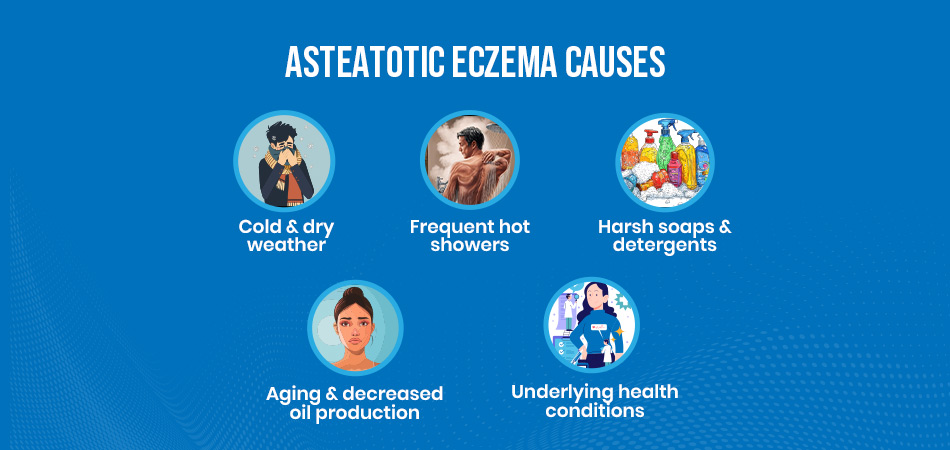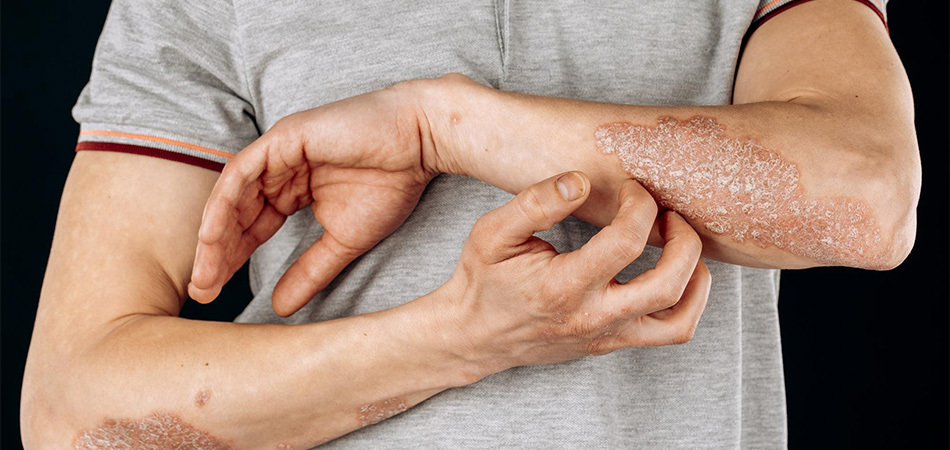Does your skin feel tight, itchy, and cracked, especially in winter? If so, you may be experiencing asteatotic eczema. This condition often leads to dry, scaly, and irritated skin, mainly affecting older adults and individuals in colder climates. However, without proper care, the symptoms can worsen, making daily activities uncomfortable.
Therefore, understanding asteatotic eczema is essential for managing its effects. Moreover, this guide explains the condition in detail, covering its causes, symptoms, treatment options, and preventive measures. Additionally, by the end, you will clearly know how to protect your skin and reduce discomfort.
What is Asteatotic Eczema?
Asteatotic eczema is a common skin condition that results in extreme dryness and cracking. In fact, it is often called winter eczema on hands because it worsens in cold, dry weather. Nonetheless, this form of eczema affects the legs, arms, and lower back, making these areas prone to irritation.
Is It the Same as Xerotic Eczema?
Many people refer to asteatotic eczema as xerotic eczema because both involve dry, irritated skin. However, asteatotic eczema causes deeper cracks that resemble a dry riverbed pattern. Moreover, this condition typically appears in older adults due to decreased oil production in the skin, making it harder to retain moisture.
Causes of Asteatotic Eczema
Several factors contribute to asteatotic eczema. The most common include:
- Cold, dry weather: Firstly, low humidity removes moisture from the skin.
- Frequent hot showers: Secondly, hot water strips natural oils from the skin.
- Harsh soaps and detergents: Chemical-based products irritate sensitive skin.
- Aging and decreased oil production: Additionally, the skin produces less sebum with age, leading to dryness.
- Underlying health conditions: Lastly, issues like hypothyroidism and nutritional deficiencies increase the risk.

Why Winter Worsens Eczema – And How to Get Help
During winter, indoor heating reduces air moisture levels. However, this lack of humidity dries out the skin, making eczema symptoms more severe. In addition, the lower legs, hands, and back are the most affected areas because they have fewer oil glands.
According to a study published in Clinical and Experimental Dermatology, skin hydration decreases by 25% in winter, increasing eczema flare-ups. (Source)
For those experiencing persistent symptoms, seeking expert advice from a physician can help determine the best treatment approach. Therefore, if you are dealing with eczema, get an immediate specialist physician’s opinion and plan treatment options.
Symptoms: How to Identify Asteatotic Eczema?
Asteatotic eczema causes visible and uncomfortable skin changes. Early detection helps prevent worsening symptoms. Therefore, look for these common signs:
- Patches of dry skin that feel rough and scaly
- Persistent itching and discomfort
- Redness and inflammation, especially on the legs and hands
- Cracked skin that may bleed in severe cases
When Should You See a Doctor?
Mild asteatotic eczema improves with skincare. However, some cases require medical attention.
- Deep cracks that bleed or cause pain need evaluation.
- Signs of infection, like pus, swelling, or warmth, indicate a need for treatment.
- If over-the-counter products do not help, a dermatologist may prescribe stronger medications.
Can Gut Health Influence Eczema Symptoms?
Emerging research suggests a link between gut health and eczema. Moreover, scientists have found that people with eczema often have an imbalance in gut bacteria. However, related research in other Frontiers journals indicates that probiotics can enhance skin health by reducing inflammation. For instance, a study in Frontiers in Cellular and Infection Microbiology found that probiotics increase serum IL-10 levels and induce regulatory T cells, thereby decreasing IL-17 levels and acting as antioxidants.
Additionally, research in Frontiers in Physiology demonstrated that probiotics improve skin hydration and reduce wrinkle depth.
Asteatotic Eczema Treatment: What Works Best?
Managing asteatotic eczema requires a consistent skincare routine. Furthermore, hydration and protection are key.
Moisturizers: Thick Creams and Ointments
Thick creams and ointments create a protective barrier. However, dermatologists recommend petroleum jelly and ceramide-based creams. Nevertheless, research shows that moisturizers reduce eczema symptoms by up to 50% (Source).
Bathing Habits: Lukewarm Water and Gentle Cleansers
Hot showers strip natural oils. Instead, use lukewarm water and mild cleansers. Moreover, avoid harsh soaps and alcohol-based products.
Medications: Topical Steroids for Flare-Ups
Severe cases benefit from low-dose topical steroids. Moreover, these reduce redness and itching quickly. Therefore, always follow a doctor’s instructions.
Lifestyle Changes: Protective Clothing and Gentle Products
- Firstly, wear gloves during winter to prevent skin damage.
- Secondly, choose fragrance-free and hypoallergenic skincare products.
Can Home Remedies Help?
Some natural treatments relieve symptoms.
- Oatmeal baths soothe itching and reduce inflammation.
- Coconut oil locks in moisture and prevents further dryness.
However, home remedies do not replace medical treatments. Therefore, if symptoms persist, seek professional help.
Explore current atopic dermatitis clinical studies for new treatment options.
A New Approach to Managing Asteatotic Eczema
Asteatotic eczema, also known as winter eczema, causes dry, cracked, and itchy skin, especially in colder months. Factors like low humidity, aging, and harsh skincare products can worsen symptoms, leading to discomfort and irritation. This clinical trial aims to evaluate an investigational treatment that may help restore skin hydration and reduce flare-ups.
If you’re experiencing persistent dryness and itching, consider participating to explore new treatment possibilities.
How to Prevent Asteatotic Eczema?
Preventing asteatotic eczema starts with daily skincare habits. These steps help maintain skin moisture and prevent flare-ups:
- Use a humidifier to add moisture to indoor air.
- Apply a thick moisturizer immediately after bathing to lock in hydration.
- Choose fragrance-free skincare products to reduce irritation.
- Drink enough water to keep the skin hydrated from within.
Does Diet Play a Role?
What you eat affects your skin’s health. Omega-3 fatty acids, found in fish and flaxseeds, help maintain moisture. Staying hydrated also prevents excessive dryness.
Living with Asteatotic Eczema: Tips for Long-Term Relief
Managing asteatotic eczema requires a long-term approach. However, daily care reduces flare-ups and discomfort. Here are some tips:
- Moisturize multiple times a day, especially after washing hands or showering.
- Avoid prolonged hot showers, as they strip natural oils.
- Wear soft, breathable fabrics to prevent irritation.
- Use gentle, fragrance-free laundry detergents to avoid skin reactions.
Regular care makes a difference. Small changes in your routine keep your skin healthy year-round.
Conclusion
Asteatotic eczema can be uncomfortable, but proper care makes a big difference. Daily hydration, gentle skincare, and protective habits help manage symptoms. Therefore, using thick moisturizers and avoiding harsh products keeps the skin healthy. Research also supports the role of omega-3s and hydration in maintaining moisture levels.
However, some cases need medical attention. Deep cracks, infections, or persistent symptoms require a dermatologist’s care. Nonetheless, treatment options continue to improve, offering better relief for those affected.





